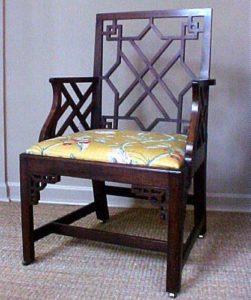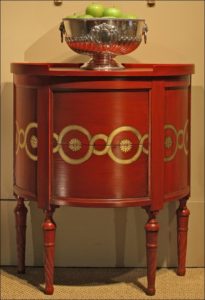
With the Chippendale tercentenary nearly over, it’s about time I put in my oar. For my gentle readers, all of whom are paragons of erudition, none will be surprised to find that, for the less cultured, if any name is familiar in the field of the decorative arts, that name has to be Chippendale. For myself, too, with my sainted grandmother from whom I doubtless acquired whatever appreciation I have for art and antiques, two of her proudest possessions were a pair of 19th century luncheon plates she kept hung on the wall in a pattern that said on the reverse ‘Old English Chippendale’.

Georgian armchair, to a Chippendale design
What I mean to say in this context is that the name of Thomas Chippendale has over time been applied to virtually anything vaguely 18th century in appearance not just in the English but also in the decorative arts of America. Why this has been so will be the subject, I can’t really say of any focused study, but certainly of my musings over the coming few days. If nothing else, these series of blog posts give me a happy excuse of revisiting the work of the late Christopher Gilbert, whose compendious The Life and Work of Thomas Chippendale, though originally published in 1978, is still regarded as the reigning authority, and characterized recently by the eminent furniture historian Adam Bowett as ‘magisterial’. Giving Dr Bowett his due, I will look at new Chippendale scholarship he’s compiled, contained in the catalog prepared for ‘Thomas Chippendale 1718-1779: A Celebration of British Craftsmanship and Design’.
 It seemed appropriate at the time, though now seems mawkish, but Keith McCullar and I were excited to offer, nearly 20 years ago now, an armchair to a Chippendale design, and in our excitement, felt we were obliged to illustrate the pattern in Chippendale’s Gentleman’s and Cabinet-Maker’s Director in our trade cards. A bit jejune? Possibly, but now 20 years on, we still link our trade style with the master’s design. I will, though, try to be shall we say temperate in my remarks.
It seemed appropriate at the time, though now seems mawkish, but Keith McCullar and I were excited to offer, nearly 20 years ago now, an armchair to a Chippendale design, and in our excitement, felt we were obliged to illustrate the pattern in Chippendale’s Gentleman’s and Cabinet-Maker’s Director in our trade cards. A bit jejune? Possibly, but now 20 years on, we still link our trade style with the master’s design. I will, though, try to be shall we say temperate in my remarks.





